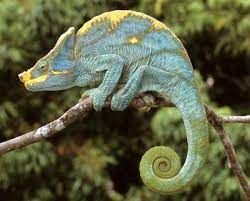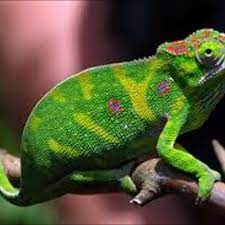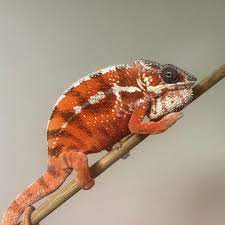Find Your Perfect Chameleon Companion on Reptilessales.com
When searching for a chameleon companion on Reptilessales.com, you have many options to choose
from to find your perfect match.
Size
Chameleons for sale range greatly in size, from the small, 4-inch dwarf chameleons to the large Parson’s chameleon which can reach up to 2 feet in length. For beginners, a smaller chameleon may be easier to care for as they require less demanding enclosures and less food. Larger chameleons, while more impressive, require significant commitments to proper care and housing.
Age
Both juvenile and adult chameleons are available. Juveniles may be slightly less expensive, but require additional time, care, and financial commitment as they grow into adults. Adult chameleons are ideal for those looking to avoid the added responsibility of raising a juvenile.
Color and Pattern
Chameleons are popular for their ability to change color, but different species feature different color ranges and patterns. Some species like the panther chameleon are prized for their bright colors and distinct patterns. Others like the veiled chameleon tend to be more drab. Choose a color and pattern that you find most appealing.
Price
Chameleon prices can range from $30 up to $3,000 or more for rare color morphs. In general, larger, more colorful, and less common species tend to cost significantly more. But with some searching, you can likely find a chameleon that matches your desired traits and budget.
By considering these factors, you can find a chameleon companion on Reptilessales.com that matches what you’re looking for in size, age, color, and price. With the right choice and commitment to good care, you’ll have a fascinating new family member to enjoy for years to come.
Selection of Healthy Baby Chameleons for Sale Near Me
When shopping for chameleons online, selecting a healthy baby is critical to getting your new pet off to the best start. Look for reputable breeders with a proven track record of producing vibrant, thriving chameleons. ###Inspect photographs carefully
Examine photos of the actual baby chameleons for sale to check for signs of good health. Look for chameleons with bright, alert eyes, a rounded body, and a fat tail – indicators the animal is well-fed. Check that the limbs, claws, and tail are symmetrical and properly developed. Look for clear, smooth skin and even coloration. Avoid chameleons with sunken eyes, protruding bones, or dull coloring, as these can indicate dehydration, malnutrition or illness.
Read reviews from other customers
Search online for reviews of the breeder and check what other customers say about their experience and the health of the chameleons they received. Look for mostly positive reviews mentioning healthy, energetic chameleons that survived and thrived. Some negative reviews are normal, but avoid breeders with a pattern of selling unhealthy or short-lived chameleons.
Ask about feeding, handling and shipping
Inquire about the breeder’s feeding, hydrating and handling practices to ensure the chameleons for sale have been properly cared for and socialized from an early age. Ask how chameleons are packaged and shipped to minimize stress; look for options like overnight shipping and heat packs depending on the weather. Reputable breeders will be happy to answer questions and provide specifics about their breeding and shipping procedures.
With some research into photos, reviews and breeding practices, you can choose a healthy baby chameleon that will bring you years of enjoyment. Starting with a vibrant pet from a reputable breeder is the best way to begin your exciting journey into chameleon ownership.
Reptilessales.com Offers a Variety of Chameleon Species
Reptilessales.com Offers a Variety of Chameleon Species
Reptilessales.com offers a wide selection of chameleons for sale, including several popular species and color variants. Prospective owners can choose from common chameleons like veiled chameleons, panther chameleons, and Jackson’s chameleons as well as more exotic species such as parson’s chameleons, oustalet’s chameleons, and carpet chameleons.
The veiled chameleon, also known as the Yemen chameleon, is one of the most popular pet chameleon species. It has a distinctive helmet-like casque on its head and a prehensile tail. The panther chameleon gets its name from the varied color patterns of blacks, greens, and reds on the males. Females tend to be more drab in color. The Jackson’s chameleon has three horns on its head and a saw-toothed crest down its back. Males are generally more vividly colored than females.
For those interested in rare or unique chameleons, reptilessales.com offers species like the Parson’s chameleon, native to East Africa, and the Oustalet’s chameleon found in Madagascar. The flat-bodied carpet chameleon inhabits the rainforests of Southeast Asia and gets its name from its ability to blend into the leaf litter on the forest floor.
In summary, reptilessales.com maintains a diverse collection of chameleons from common pets to exotic species. With healthy, captive-bred chameleons and a knowledgeable staff, they are a reputable source for these remarkable lizards. Whether you are a beginner looking for your first chameleon or an experienced owner interested in a new species, reptilessales.com likely has a chameleon that will fit your needs.
How much are chameleons For Sale
Chameleons can vary significantly in price depending on the species, age, size, color, and quality. As with any pet, the initial cost is only part of the total required investment to properly care for chameleons. You’ll also need a suitable enclosure, lighting, heating, and other essential equipment. The cost to feed and care for a chameleon can be $20-50 per month.
Panther Chameleons
Panther chameleons, such as Ambilobe or Nosy Be panthers, are one of the most popular pet chameleon species. Hatchling panther chameleons typically range from $75 to $200 each, depending on color and locality. Adults can cost $200 to $500 each. Some of the more rare color variants and locales can sell for $1,000 or more for a quality breeder or show animal.
Veiled Chameleons
Veiled chameleons, such as Yemen or Sana’a veileds, are also commonly kept as pets. Hatchling veiled chameleons usually range from $30 to $100 each, while adults typically cost $75 to $250 each. The more rare blue and red color variants tend to sell for higher prices.
Other Species
Some of the smaller chameleon species, such as flap-necked, dwarf, and pygmy chameleons, typically cost between $30 to $200 each depending on the specific type and age. The large, horned chameleon species like Jackson’s and Fischer’s tend to sell for $200 to $500 or more each due to their size and unique appearance. Rare and imported chameleons from locales like Mt. Kenya, Usambara, and Carpet can sell for $500 to $5,000 or more each.
In summary, you can expect to pay between $30 to $5,000 or more for a pet chameleon, depending on the species and other factors. Be sure to buy from a reputable breeder or company to ensure a healthy animal and accurate information regarding its care requirements. The initial cost is only part of the necessary investment to properly care for a chameleon over its lifetime.
Frequently Asked Questions About Buying a Chameleon Online
What do chameleons eat?
Chameleons are insectivores, feeding primarily on live insects like crickets, waxworms, mealworms, and feeder roaches. The size of the feeder insects should be appropriate for the size of the chameleon. As a general rule, do not offer any insects larger than the width between the chameleon’s eyes.
Chameleons also require additional supplements to ensure they get proper nutrition. Gut-loaded insects and calcium/vitamin powder should be provided 2-3 times a week. The supplements stick to the insects and are ingested by the chameleon when it eats the insects. Always follow the directions on the product packaging for how much to use based on the age and size of your chameleon.
Some chameleon species, like veiled chameleons, can also eat small amounts of plant matter, so you can offer dark leafy greens, beans, and peas 2-3 times a week. However, the majority of a chameleon’s diet should still consist of protein-rich insects. Always have a shallow water bowl available for your chameleon as well, changing the water daily and misting your chameleon with lukewarm water to keep it hydrated.
How do chameleons change color?
Chameleons are well known for their ability to change color. They can shift between green, brown, and a range of colors in between. A chameleon changes color through special pigment cells in its skin called chromatophores. By expanding and contracting these cells, the chameleon can control how much light is absorbed and reflected, thereby altering its appearance.
Several factors influence a chameleon’s color change:
- Temperature regulation – Chameleons darken in cold temperatures to absorb more heat and lighten in warm temperatures to reflect heat.
- Camouflage – Chameleons change to match their surrounding environment, such as adopting browns and greens. This helps them hide from predators and sneak up on prey.
- Mood – A chameleon may darken in color when angry or defensive or lighten when calm or mating. Dark colors are often a sign of stress or aggression in chameleons.
- Light exposure – Chameleons tend to darken in intense light and lighten in dimmer light. This is linked to temperature regulation and camouflage.
- Health – A chameleon’s ability to change color can be an indicator of its health. Dull, dark colors or an inability to change color may signal illness or malnutrition.
How long do chameleons live?
With proper care, chameleons can live 4 to 10 years on average depending on the species. Some of the larger chameleon species, such as panther
Animals
Animals
Animals
Animals
Animals
Animals
Animals
Animals
Animals
Animals











